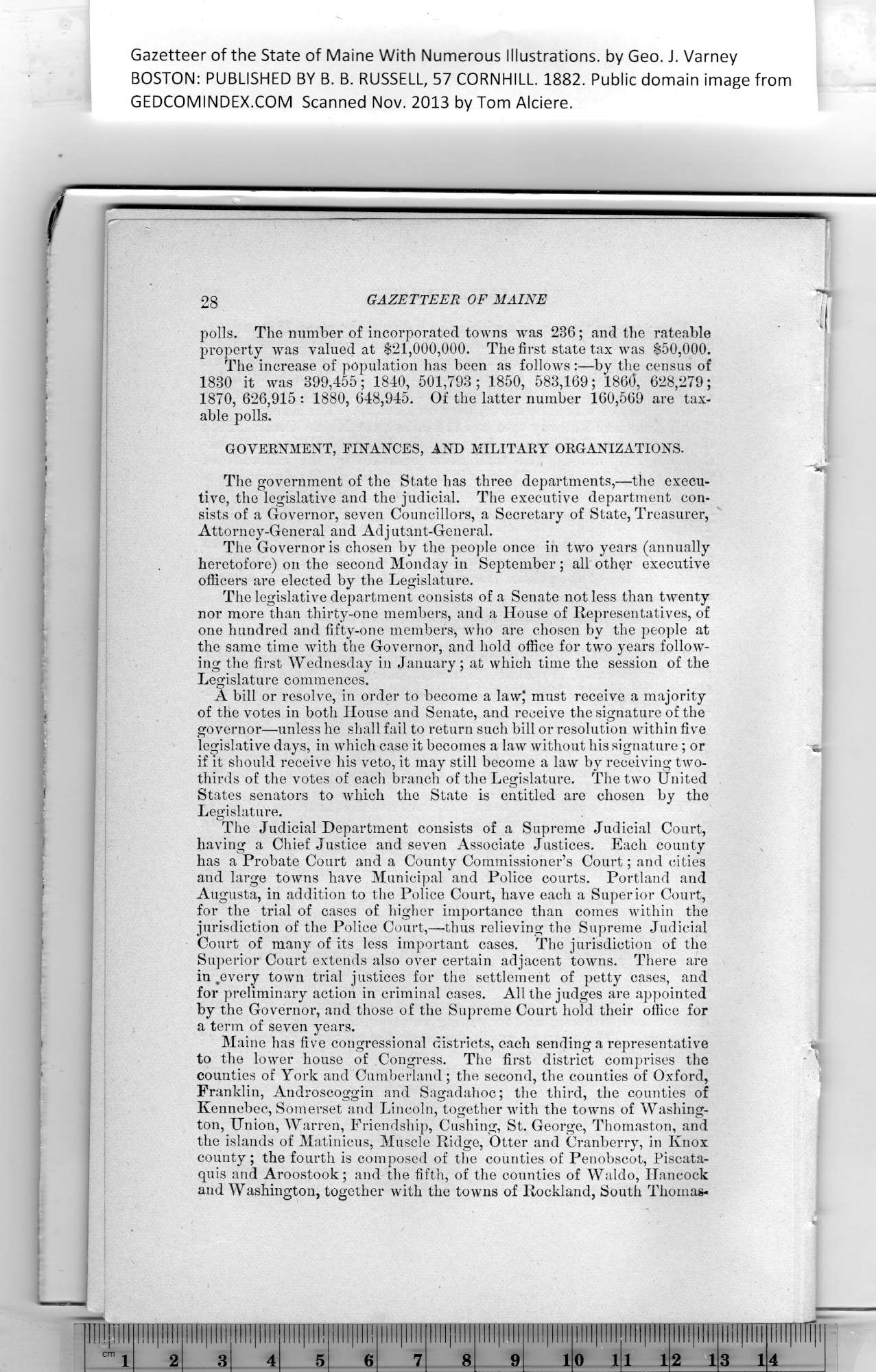|
Gazetteer of the State of Maine With Numerous Illustrations, by Geo. J. Varney
BOSTON: PUBLISHED BY B. B. RUSSELL, 57 CORNHILL. 1882. Public domain image from
28 GAZETTEER OF MAINE
polls. The number of incorporated towns was 236; and the rateable
property was valued at $21,000,000. The first state tax was $50,000.
The increase of population has been as follows :—by the census of
1830 it was 399,455; 1840, 501,793; 1850, 583,169; I860, 628,279;
1870, 626,915 : 1880, 648,945. Of the latter number 160,569 are tax-
able polls.
GOVERNMENT, FINANCES, AND MILITARY ORGANIZATIONS.
The government of tbe State has three departments,—the execu-
tive, the legislative and the judicial. The executive department con-
sists of a Governor, seven Councillors, a Secretary of State, Treasurer,
Attorney-General and Adjutant-General.
The Governor is chosen by the people once in two years (annually
heretofore) on the second Monday in September; all other executive
officers are elected by the Legislature.
The legislative department consists of a Senate not less than twenty
nor more than thirty-one members, and a House of Representatives, of
one hundred and fifty-one members, who are chosen by the people at
the same time with the Governor, and hold office for two years follow-
ing the first Wednesday in January; at which time the session of the
Legislature commences.
A bill or resolve, in order to become a law} must receive a majority
of the votes in both House and Senate, and receive the signature of the
governor—unless he shall fail to return such bill or resolution within five
legislative days, in which case it becomes a law without his signature; or
if it should receive his veto, it may still become a law by receiving two-
thirds of the votes of each branch of the Legislature. The two United
States senators to which the State is entitled are chosen by the
Legislature.
The Judicial Department consists of a Supreme Judicial Court,
having a Chief Justice and seven Associate Justices. Each county
has a Probate Court and a County Commissioner’s Court; and cities
and large towns have Municipal and Police courts. Portland and
Augusta, in addition to the Police Court, have each a Superior Court,
for the trial of cases of higher importance than comes within the
jurisdiction of the Police Court,—thus relieving the Supreme Judicial
Court of many of its less important cases. The jurisdiction of the
Superior Court extends also over certain adjacent towns. There are
in .every town trial justices for the settlement of petty cases, and
for preliminary action in criminal cases. All the judges are appointed
by the Governor, and those of the Supreme Court hold their office for
a term of seven years.
Maine has five congressional districts, each sending a representative
to the lower house of Congress. The first district comprises the
counties of York and Cumberland; the second, the counties of Oxford,
Franklin, Androscoggin and Sagadahoc; the third, the counties of
Kennebec, Somerset and Lincoln, together with the towns of Washing-
ton, Union, Warren, Friendship, Cashing, St. George, Thomaston, and
the islands of Matinicus, Muscle Ridge, Otter and Cranberry, in Knox
county; the fourth is composed of the counties of Penobscot, Piscata-
quis and Aroostook; and the fifth, of the counties of Waldo, Hancock
and Washington, together with the towns of Rockland, South Thomas-
PREVIOUS PAGE ... NEXT PAGE
This page was written in HTML using a program written in Python 3.2
|
